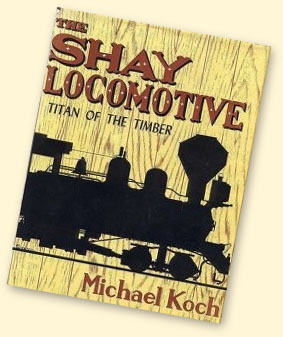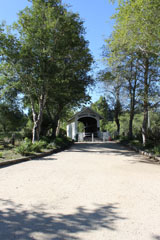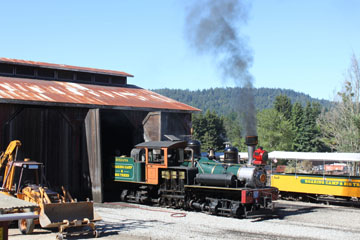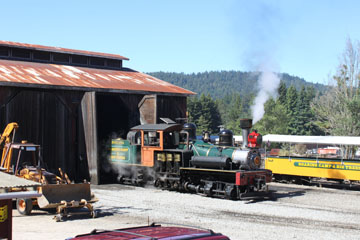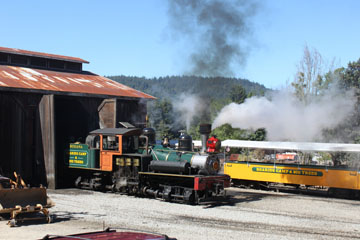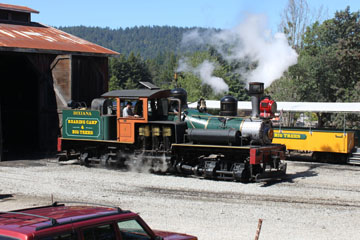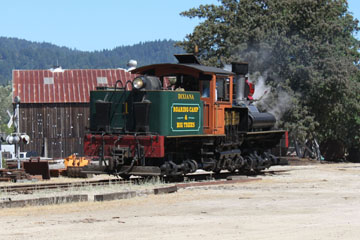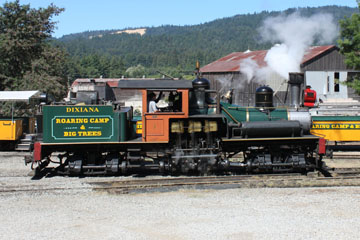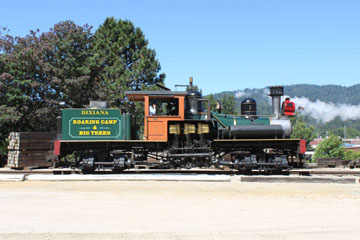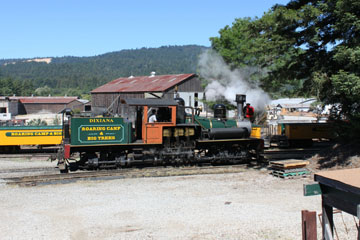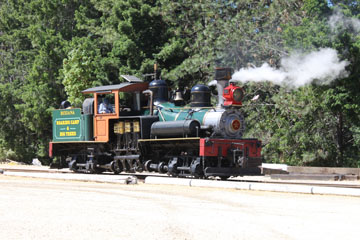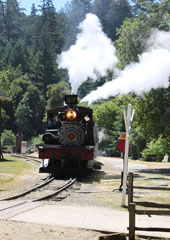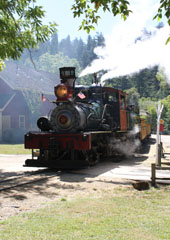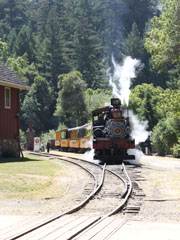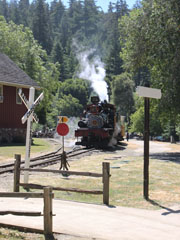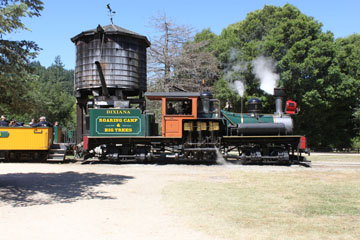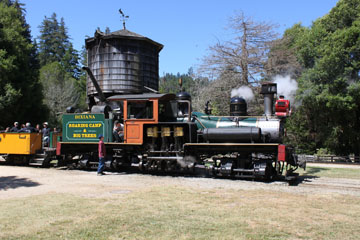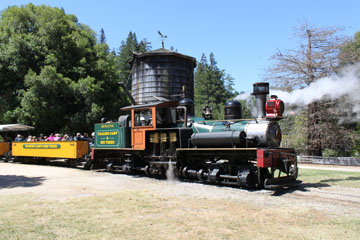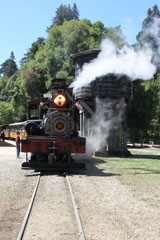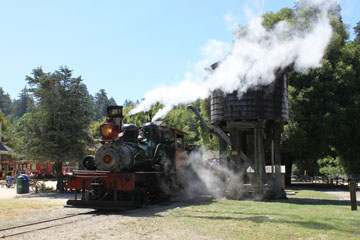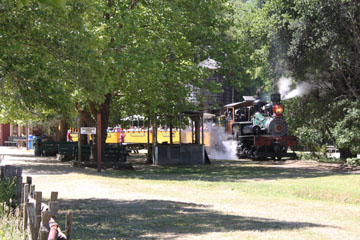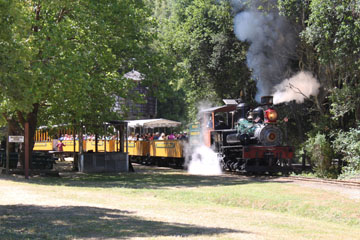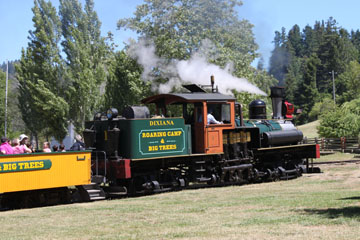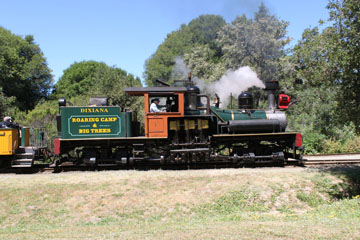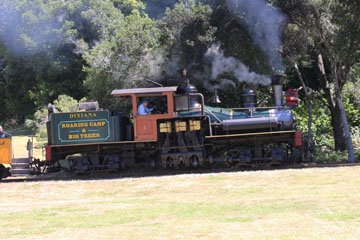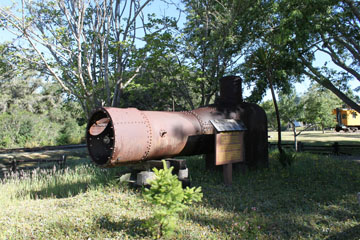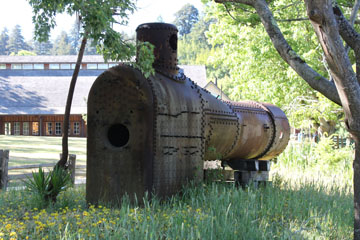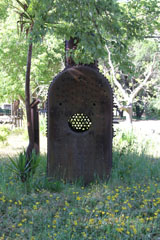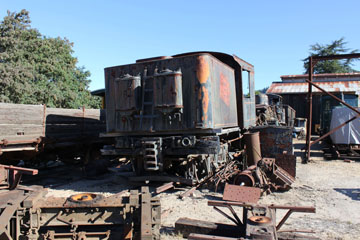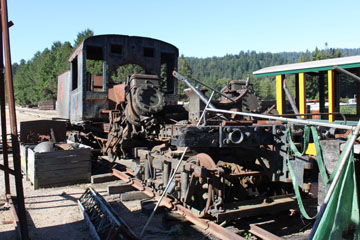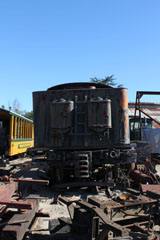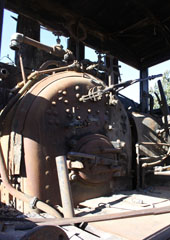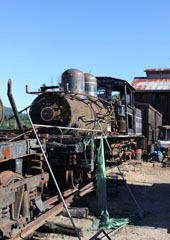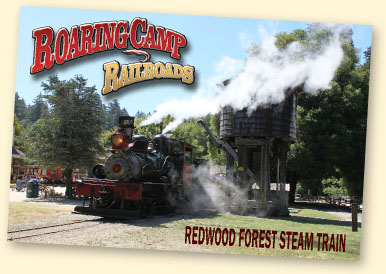

The Roaring Camp & Big Trees Railroad is a 36” gauge tourist railroad running from the Roaring Camp depot in Felton, CA, up to the top of nearby Bear Mountain. The 3¼ mile climb through a redwood forest has some of the steepest grades west of the Mississippi (up to 9.5%).
The area through which the line runs was bought in 1867 by San Francisco businessman Joseph Warren Welch to preserve the giant redwood trees from logging, and Big Trees Ranch as it was known, was the first property in the state acquired specifically for that purpose. In 1930, the Welch family sold part of the property to Santa Cruz County, which eventually became part of the Henry Cowell Redwoods State Park.
F. Norman Clark was founder of the Roaring Camp and Big Trees Railroad. Clark acquired a ninety-nine year lease on part of the Big Trees Ranch, and the first scheduled train trip ran on 6th April 1963. Hauled by the recently restored two truck Shay locomotive “Dixiana” #1, it carried forty-four ticketed passengers. The railway route was laid out so that as few trees as possible would have to be cut on the 170 acre site.

Left, a covered bridge links the main car park to the depot building. Built in 1969, it is the first Pratt-Truss covered bridge built in California since 1896 and the shortest covered bridge in the US.
Below, the depot has shops, a restaurant and ticket office.

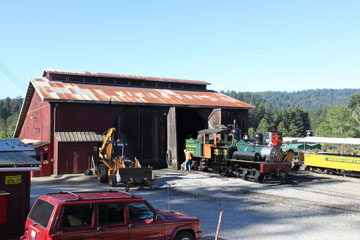
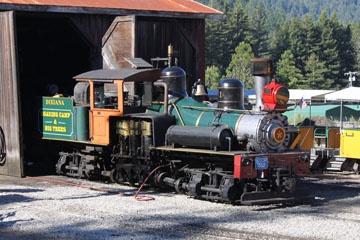
During the summer season, the first train departs at 11.00 am but if you arrive earlier, you can see the locomotive being readied for service. I arrived shortly after 8.30 am and #1 was just being steamed up at the engine house.
The round trip to Bear Mountain takes about an hour and a quarter and motive power depends on the time of year and passenger numbers. From December to March there is only one trip on week days at 12.30 pm hauled by a diesel locomotive. Steam trains operate one trip daily at 12.30 on the weekends.
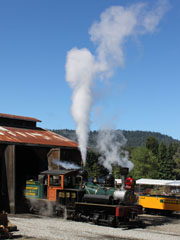
Above, at full pressure, #1 blows its stop cock.
It was built by Lima in 1912 as standard gauge #3 for the Alaculsy Lumber Company in Conasauga, TN. It was sold to the Atlanta, GA, dealer Southern Iron & Equipment in 1919 and then became Smoky Mountain Railroad #3 at the W. M. Ritter Lumber Co., in Proctor, NC, where it was converted to 36" gauge. It moved to McClure, VA, and was then sold to the Coal Processing Corporation in Dixiana, VA, in 1938.
In 1958, F. Norman Clark found the engine abandoned near a coal mine in Virginia. He bought it in 1962.
Left, #1 leaves the engine house and reverses alongside the car park to the depot.
Below, the engine collects the day’s
consist. The length of tail tracks on the route’s switchback limits the length of trains that can be operated to six cars or fewer.
Above, pulling back into the depot ready to take on passengers.
During restoration, the locomotive was converted from a coal burner to an oil burner and
renumbered #1 as it was the first locomotive
owned and operated over the Roaring Camp and Big Trees. It was also named after the location, Dixiana, out of which its last owner, the Coal Processing Corp., operated. If there was ever a township at Dixiana it is now gone, although there are still some large open cast mines operating nearby.
Left and below, #1 standing at the depot after taking on the morning’s passengers.
The American Society of Mechanical Engineers designated Roaring Camp's Shay, Climax and Heisler engines National Mechanical Engineering Historical Landmark #134 in 1988.
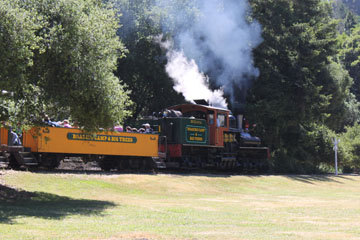
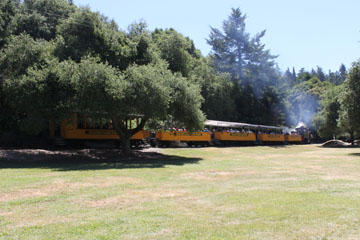
Left and above, #1 pulling out of the depot and passing through a 180° curve as it starts its climb to Bear Mountain.
#1 weighs 69,500 lbs empty. With three vertically mounted 10” x 12” cylinders, it operates at a
boiler pressure of 180 psi delivering 16,900 lbs tractive effort. You can see more Shays on the Cass Scenic Railroad page of this website, the B&O Museum Roundhouse page, the Travel Town pge, Railroad Museum of Pennsylvania Train Shed page and the North Carolina Museum of Transportation page.


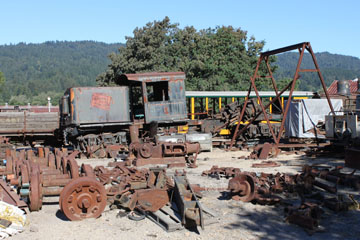
Behind the engine house is a graveyard of sorts, which includes what may be the last Climax locomotive built. Construction #1692 outshopped in December 1928, it was built as #3 for the Elk River Coal & Lumber Co., in Swandale, WV.
In 1959, Elk River Coal & Lumber was bought by the W. M. Ritter Lumber Co., which merged into the Georgia-Pacific Corp., the following year. In 1963, #3 was sold to Carroll Stahl to run on the tourist Carroll Park & Western Railroad in Bloomsburg, PA. The railroad closed in 1972 and #3 was sold to the Roaring Camp in 1977.
Left, the boiler is gone. The locomotive weighed 100,000 lbs when built and has 12½” x 14” inclined cylinders. A coal burner operating at 200 psi, it delivered 22,000 lbs tractive effort.
Above and right, note the old link and pin coupler on the rear of the fuel bunker.

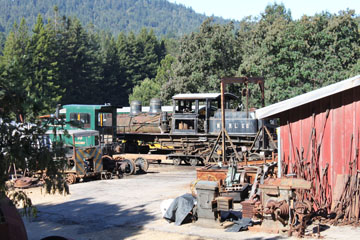
This two truck Shay was built in 1912 for the 36” gauge Elk & Little River Railroad in Gassaway, WV.
It went through a series of owners, including W. M. Ritter, who converted it to a 42” gauge in 1920. It was bought by the Roaring Camp in 1990.
As built, #6 weighed 53,900 lbs. It has three 8” x 12” cylinders. Operating a boiler pressure of 160 psi, it delivered 14,150 lbs tractive effort.
Roaring Camp plans to restore the locomotive to its original 36” gauge as funds become available.

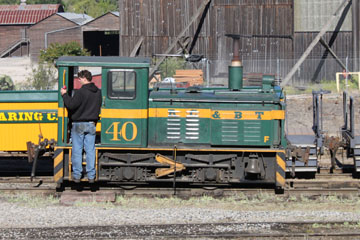

Built in 1958 by the Plymouth Locomotive Works in Plymouth, OH, this 12-ton four-wheeler came from the Kaiser Steel Corp., works in Fontanta, CA, where it was #1021. It was acquired by Roaring Camp in 1978.
#40 works as the shop switcher, spotting steam locomotives and providing other backup duties, as well as serving as the usual weekday motive power during the off season. Its paint scheme was apparently inspired by the Chicago & Northwestern scheme used on the former Georgetown Loop Railroad.


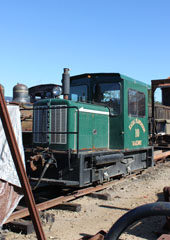
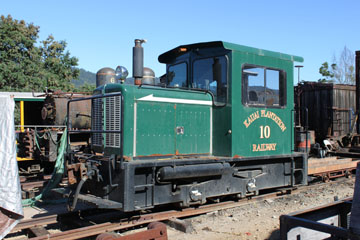
I haven’t been able to find out much about this four-wheel switcher except that it was built by the Whitcomb Locomotive Works in Rochelle, IL. It operated on the Kauai Plantation Railway and was bought by Roaring Camp in 2010.
The 36” gauge Kauai Plantation Railway opened for business in January, 2007 as “the first new railroad to be built in Hawaii in 100 years”. It follows a three mile loop through agricultural displays on the historic Kilohana estate and plantation devoted to preserving the island’s plantation-era heritage.
Related Links:
Location of Roaring Camp & Big Trees Railroad
Roaring Camp & Big Trees Railroad
Geared Steam
Shay Locomotives
Send a comment or query, or request permission to re-use an image.
Michael Koch's The Shay Locomotive: Titan of the Timber, published by World Press in 1971 is currently the most authoritative source for information on Shays, although it is now a collectors item and commands very high prices (click on the cover to search for this book on Bookfinder.com).
